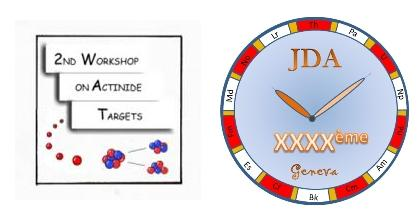Speaker
Ladislav Havela
(Charles University Prague)
Description
In the U-Pu phase diagram a mysterious ζ-U-Pu phase exists over a large composition range (35-70 % U). This cubic (rhombohedrally distorted) phase has 10 different crystallographic positions, randomly occupied by U and Pu. When compared with other Pu allotropic phases, its volume density of 18.55 g/cm3 fits about half way between a-(19.92 g/cm3 ) and b-Pu (17.70 g/cm3).This value is much smaller than the d-Pu and presents clear interesting features. Indeed recent theoretical analyses suggest that this is not the volume density but the 5f occupancy, which decides about the type of ground state in Pu system. Besides fundamental purposes, related mostly to a realistic description of Pu-based systems, the ζ-phase is an important part of potential future metal nuclear fuels.
Here we report on basic properties at low temperature of samples presenting ζ-U-Pu phase. Two samples with concentrations U59Pu41 and U41Pu59 were synthesized by arc melting and annealing. XRD revealed the proper cubic structure with space group Pm-3m (the small rhombohedral distortion with angle a 89.7 deg was not considered during the refinement) with a small trace of UO2. The lattice parameters U41Pu59: a = 10.664(2) Å, U59Pu41: a = 10.661(1) Å are close to values reported in literature.
The samples have been studied by magnetic and specific heat studies using a SQUID magnetometer (MPMS-7) and a PPMS-9 T. Both concentrations turned out to be weak paramagnets. In this case the correction for the sample holder becomes important, representing more than 10 % of the samples susceptibility. The obtained data exhibit only a very weak T-dependence that could not be analysed in terms of a modified Curie-Weiss law. The examination of absolute values reveals, that compared to the values of Pu phases or a-U, both U-Pu samples present higher susceptibility. At room temperature, one obtains 8.0x10-9 m3/mol for U0.41Pu0.59 and 7.3x10-9 m3/mol for U0.59Pu0.41 while one gets 8.5x10-8 m3/mol and 7.7x10-8 m3/mol respectively in a broad weak maximum below T = 50 K. This is clearly higher than for a-U (4.8x10-9 m3/mol) or for a-Pu (6.7x10-9 m3/mol). Nevertheless, this enhancement can not be assimilated to magnetism. A tentative analysis of the contribution of Pu to susceptibility leads to assume that the contribution to susceptibility of U corresponds to that of a respective fraction U in the sample. It has been shown that in PES spectra, the character of Pu-5f states does not change significantly from the situation of a-U. Assuming that the U contribution corresponds to that of the same amount of a-U, we obtain 1.02x10-8 m3/mol Pu for U0.59Pu0.41 and 1.09x10-8 m3/mol Pu for U0.59Pu0.41. These results suggest that the relative contribution of Pu may in fact increase if Pu is more diluted. One should notice that such susceptibility values per Pu are in the ζ-U-Pu phase higher that e.g. in d-Pu stabilized by various dopants or even substantially expanded by Am doping.
The heat capacity measurements reveal that the Debye temperatures are slightly higher that for d-Pu alloys (100 K) while the Sommerfeld coefficient of electronic specific heat g is lower than that for d-Pu. Comparing the two U-Pu alloys, the higher Pu concentration has the higher g-value and lower Debye temperature. The actual g-values amount to 23 mJ/mol K2 for U0.59Pu0.41 and 35 mJ/mol K2 for U0.59Pu0.41. The respective values of Debye T (153 K and 142 K) are close to the value given for a-Pu. Estimating the contribution of Pu into the g-value of the alloy, we can follow the same procedure used for susceptibility, i.e. assuming the fictitious U contribution equal to appropriate amount of a-U (g taken as 9 mJ/mol K2 for a-U). The values obtained by this way (42 mJ/mol Pu K2 for U0.59Pu0.41 and 53 mJ/mol Pu K2 for U0.59Pu0.41) are in the range of the valued reported for d-Pu, i.e. much enhanced comparing to 17 mJ/mol K2 for a-Pu. The results will be discussed in the framework of LDA+U and LDA+Hubbard I calculations.
Neither hint of superconductivity nor any phase transition has been observed on U0.59Pu0.41 by heat capacity. Despite the use of a 3He insert and the very small mass of our sample (350 mg), self heating power of 239Pu has prevented us to cool our material below 2K.
Primary author
Ladislav Havela
(Charles University Prague)
Co-authors
Alexander Shick
(Institute of Physics, Prague)
Daniel Bouexiere
(ITU Karlsruhe)
Eric Colineau
(ITU Karlsruhe)
Jean-Christophe Griveau
(ITU Karlsruhe)
Rachel Eloirdi
(ITU Karlsruhe)




